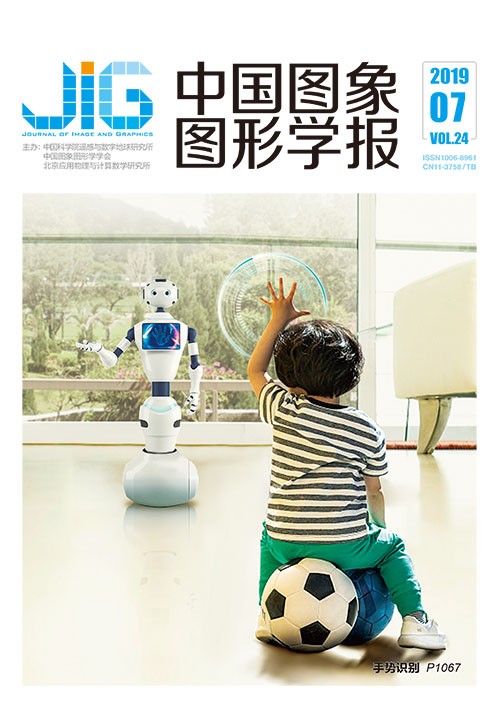
相似匹配块组的稀疏表示图像修复
摘 要
目的 传统多样本块稀疏表示的图像修复过程中,容易因为匹配样本块的错误,重构出不正确的填充块,致使在边缘部分产生不连贯的现象,然而单样本匹配填充又容易产生明显的伪影,不能保证与周围结构保持连续,以致产生明显的修复痕迹,为此,本文提出一种改进的基于相似匹配块组的稀疏表示方法。方法 首先,采用颜色信息与余弦距离结合的方法定义图像块匹配准则,在目标邻域范围内获得结构变化趋势更相似的匹配块组;然后,在稀疏重构过程中,同时考虑已知信息和估计的未知信息,利用相似块与目标块的匹配程度,对稀疏系数增加不同的权重,以此来增强筛选匹配块的能力,减少纹理模糊现象;最后,根据结构稀疏度自适应地在各结构复杂度不同的区域确定样本块尺寸,减少图像修复过程中的错误传播现象。结果 实验结果表明,本文算法改善了在边缘修复过程中产生断裂或者纹理延伸的现象,不仅在主观视觉有明显的提升,其修复结果的峰值信噪比(PSNR)相较于其他相关稀疏表示修复算法提高了0.53 dB。结论 本文算法实现了对不同结构特征的彩色破损图像的修复,在结构边缘处有理想的修复效果,并且对各种形状的破损也具有良好的修复效果。
关键词
Sparsity image inpainting algorithm based on similar patch group
Lou Xingxin, Tang Xianghong, Zhang Yue(School of Communication Engineering, Hangzhou Dianzi University, Hangzhou 310018, China) Abstract
Objective In the process of traditional patch-group-based image inpainting, synthetizing the incorrect filling patch is easy, thus causing incoherence at the edge because of incorrect matching patches. However, a traditional exemplar-based image inpainting algorithm only uses a single patch to fill a damaged area, making it prone to generate strong artifacts. It could give rise to strong inpainting trace, which affects a person’s visual sense, because of its uncertain consistency with the surrounding structure. To solve these problems, an improved sparsity image inpainting algorithm based on a similar patch group is proposed in this study. Method First, searching for similar patch groups only uses color differences, thus making it easy to match incorrect patches whose structural trend is obviously different from the target patch. The cosine distance is an effective tool for measuring the change in direction between vectors, and it can measure the proximity in the vector direction. Thus, the patch matching criterion is defined by the combination of color information and cosine distance in this study. In this manner, matching patches whose structural trend is similar to the target patch can be obtained, and the error matching rate can be reduced when matching similar patches. Second, in the process of sparse reconstruction, to enhance the capability to filter matched patches and decrease texture blur, we estimate the unknown pixels according to the similar patch group obtained in the first step. Considering that different matching patches have different filling effects on the filling area and to make the whole sparse representation model capable of filtering matching patches, we utilize known and estimated unknown information to calculate the matching degree between every similar patch and the target patch to add different weights on the sparse coefficients. Finally, repairing the detailed structure of the area with a fixed patch size is difficult because an image always has rich and varied information. Structural sparsity is used to reflect structural complexity; thus, the patch size is adaptively decided by structural sparsity in this study. Different from the method that uses a fixed threshold to determine the patch size, the proposed method iteratively calculates structural sparsity and decreases the patch size until the structural complexity of the patch is reduced to the average value, which helps reduce error propagation during image inpainting. Result This study shows several representative color images that are damaged artificially into different shapes for inpainting in Fig.5—8. In addition, it compares the repair results for the same image damaged with different kinds of shapes and provides a detailed view of the result in Fig.9. Experimental results show that the proposed algorithm is more effective in subjective vision than other related algorithms and improves the phenomenon of fracture or texture extension during the process of edge structure repair. Other experimental data are given in Tables 1-2. The results show a significant improvement in subjective vision, and the peak signal-to-noise ratio of the result is improved to approximately 0.53 dB. However, the running time is increased because the method needs to calculate the patch structure sparsity iteratively and adjust the adaptive patch size dynamically. Conclusion This study proposes a weighted sparsity image inpainting method based on a similar patch group. The method combines the features of color information and cosine distance so that trends similar to the target patch can be obtained while searching for similar patch groups. Thus, the method is precise during patch propagation. Moreover, different sparse weights are added according to the degree of similarity; thus, the structural information is preserved as much as possible during the entire process of inpainting, and texture blur is reduced. The combination of the two strategies can improve the efficiency of the image inpainting algorithm. The proposed inpainting algorithm achieves the inpainting of damaged color images with different structural features and shapes. We perform a comparison to prove that the proposed method is more efficient than existing color image inpainting methods. Results show that the improved method in this study has an ideal repair effect on the strong edge structure and multi-structure area, thus effectively improving the image restoration quality. Nevertheless, this method only utilizes the information within a certain range of the image. Therefore, several shortcomings, such as the unsatisfactory repairing result in the case of inconsistent edge structure and the inability to maintain edge curvature, still exist. Thus, our method is unsuitable for all kinds of images. Future research will focus on the recovery of the edge curve and irregular texture breakage.
Keywords
|



 中国图象图形学报 │ 京ICP备05080539号-4 │ 本系统由
中国图象图形学报 │ 京ICP备05080539号-4 │ 本系统由